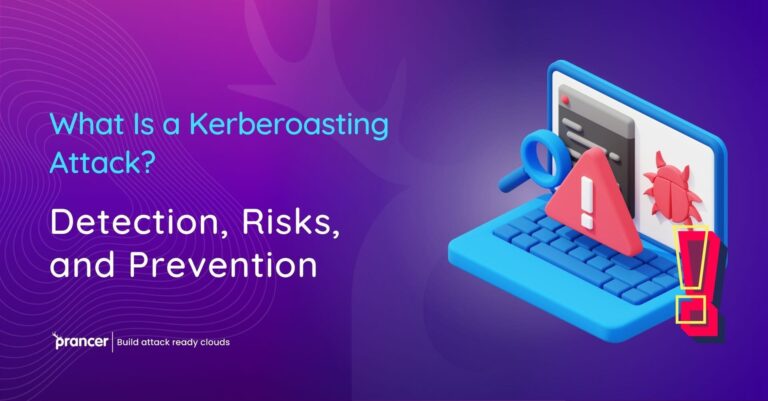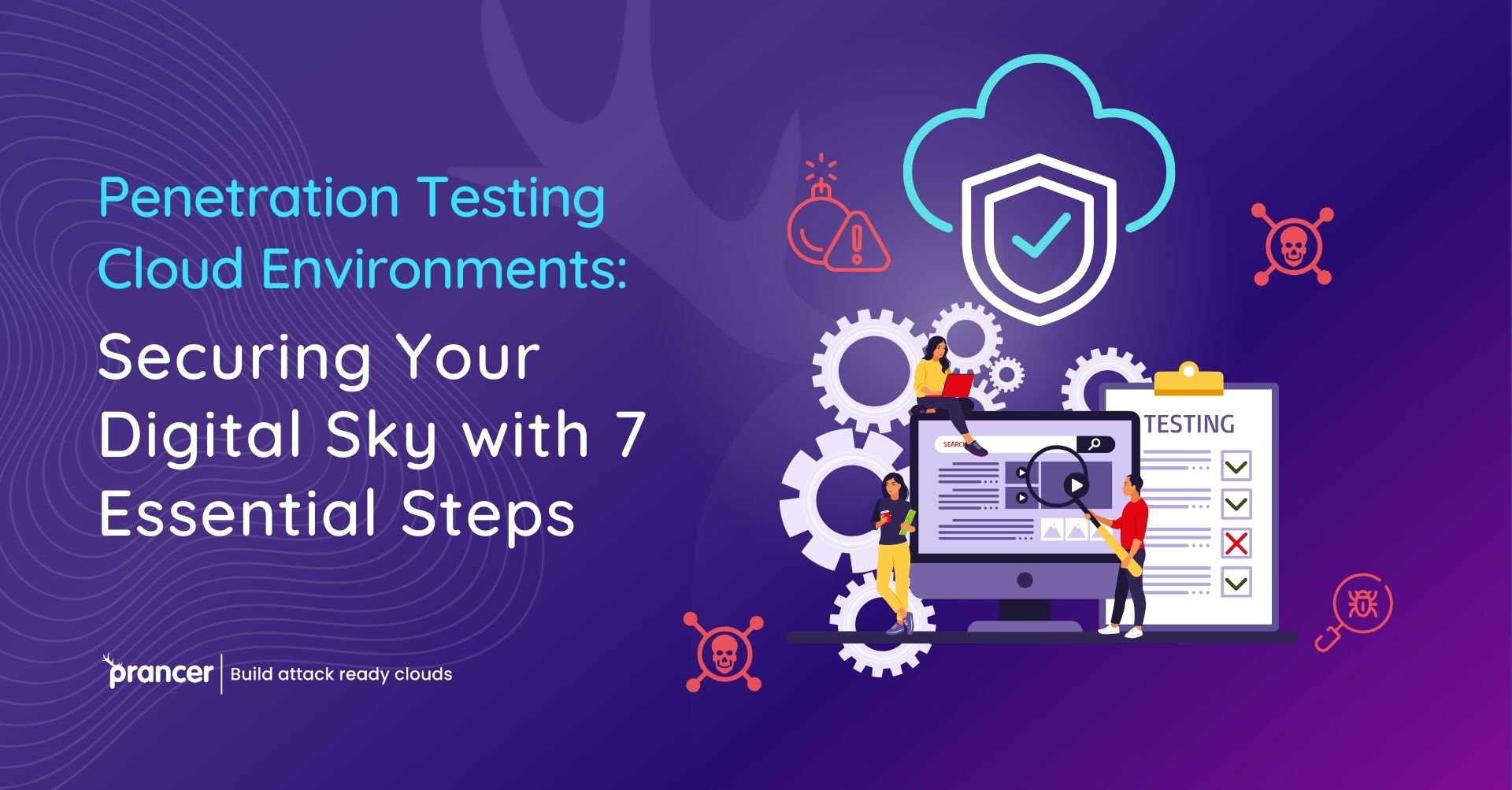

In an era where cloud services dominate the digital sphere, ensuring the integrity and security of these platforms becomes more crucial than ever. Cyber threats, both in number and sophistication, continue to rise, emphasizing the need for effective penetration testing cloud environments. In this enlightening post, we will unravel the importance and methodology behind penetration testing in the cloud and spotlight the integral role of Prancer in reinforcing your cloud security practices. Additionally, we will shed light on the differences between cloud and traditional penetration testing.
This is important, especially in this digital age where cloud services have become much part of the activities. With the increasing sophistication and prevalence of cyber threats, the importance of carrying out efficient automated penetration testing becomes more pronounced within cloud environments. To this end, this article will focus on the various essential aspects and techniques of penetration testing in cloud infrastructures regarding Prancer’s role in fortifying security measures within the cloud.
Penetration testing, while a familiar practice, takes on new complexities when applied to cloud environments. These digital realms come with their own unique challenges and opportunities. Here’s a structured approach to cloud environments, encapsulated in seven pivotal steps:
While the essence of penetration testing remains consistent across domains, discerning the nuances between cloud and traditional environments is vital:
Continuing on cloud network Automated penetration testing, it is important to acknowledge the developing trends of cloud security. For that reason, the implication of businesses to cloud platforms makes it necessary to comprehend unique problems of security in clouds. The Iterative and Incremental Nature of Cloud Threats—In this section, the importance of security assessments to be performed on a continuous basis within cloud environments is presented. In this last article, we’ll look at how ongoing vigilance and the right tools such as Prancer can help you to roll with the punches of an ever-evolving cloud security landscape. This also emphasizes the need of creating a security awareness culture within organizations, that will serve as a complement to technical safeguarding techniques. This comprehensive strategy ensures that the technical infrastructure and human aspects are congruent in fighting cloud-side cyber threats.
In the digital world of today, where everything is based on clouds, strong security steps are very important to fight smart cyber attacks. This article shows how important it is to do cloud-safe hacking right. It goes over a step-by-step process like planning, figuring out what needs fixing and using tools from Prancer in places such as AWS (Amazon Web Services), Azure or Google Cloud Platform for best results. It pushes for a careful test method, detailed reporting and constant risk management with cloud providers. The article also points out differences between cloud testing and old-fashioned tests. It stresses how both types shared responsibility, could grow big quickly, and required quick methods for temporary resources in the clouds. It needs constant watchfulness and a company culture that thinks about safety to handle the always changing threats in cloud computing.
Strategic Penetration Testing in the Cloud with Prancer’s Expertise
In the age of continuous maintenance by cloud services, trust and system safety in cloud systems are a pivotal concern. However, as cyber threats become more advanced and widespread, the importance of efficient penetration testing in cloud environments is becoming much clearer than ever before. This thought-provoking article explores the details of cloud specific penetration testing and shows Prancer’s importance in strengthening a practice with regard to cloud security.
The peculiarities of Cloud Network Penetration Testing.
Cloud allows cybersecurity practice of penetration testing to take a new dimension. These platforms present unique challenges and opportunities, necessitating a structured approach:
Scoping and Planning:
Start with a coherent representation of the cloud environment, highlighting main assets and taking into account issues such as content classification, legal obligations or security hazards.
Threat Modeling for Cloud Environments:
Formulate personalized threat models through the characterizing of cloud provider’s shared responsibility model to describe as well security responsibilities.
Automated Penetration Testing with Prancer:
Utilize automated programs such as Prancer for complete cloud system verification across prominent platforms, including AWS, Azure and GCP.
Prancer focuses on cloud security by offering automated penetration testing to address challenges specific to the cloud, and enhanced API security.
Focusing on Cloud-Specific Vulnerabilities:
Make the most of risks that are cloud-specific, including inadequate configuration and exposed storage buckets.
These cloud-oriented threats are detected through the tools that Prancer provides.
Adopting a Rigorous Testing Methodology:
Establish a regular testing regimen with vulnerability scans, simulated breaches and ethical hacking drill.
Documentation and Reporting:
Collect in-depth reports of indicators, evaluate the level of vulnerability and prepare remediation measures.
Remediation and Continuous Assessment:
Work with cloud service providers to resolve vulnerabilities and implement recommended security improvements on a regular assessment basis.
Cloud vs. Traditional Penetration Testing
Understanding the differences between cloud and traditional penetration testing is essential:
Shared Responsibility: To this end, security in cloud platforms is a shared responsibility between the service provider and user with definite roles to play.
Scalability: The cloud environments are by nature broad; therefore, the required testing methods should be flexible and vast.
Ephemeral Nature of Cloud Resources: As cloud resources are transient, there is a need for agile and dynamic form of testing methods different from the traditional static ones.
Sailing Cloud Security Trends with Prancer
With cloud security constantly developing, comprehending its specific challenges becomes essential. The constant threat of clouds demands the continuous reassessment security. Prancer’s capabilities enable continuous vigilance allowing adaptation to the morphing cloud security terrain. Moreover, promoting a culture of security in organizations complements technical safeguarding methods to ensure an integrated approach for combating threats from the cloud.
In the contemporaneous digital world dominated by clouds, effective security measures are a must to counter modern efforts at sophisticated cyber attack. This guide highlights the need for clear cloud penetration testing through a detailed process including planning, threat identification, and using Prancer’s tools to get the best results on clouds like AWS Azure GCP. It promotes structured testing approaches, detailed reporting and continuous partnerships with cloud service providers. The article then outlines the differences between cloud and traditional penetration testing, stressing that constant vigilance new a security culture is necessary to manage the growing threats in cloud computing. Ultimately, with Prancer’s help businesses will be able to address the subtleties of modern cyber attacks and safeguard their digital infrastructure from them.
Securing your cloud environment isn’t just beneficial—it’s imperative. As cloud platforms burgeon in both prevalence and complexity, maintaining a hawk-eyed vigilance against cyber threats is paramount. With cutting-edge automated penetration testing tools such as Prancer, the cloud security evaluation process becomes both meticulous and scalable. By adhering to the seven essential steps encapsulated above and leveraging Prancer’s prowess, navigating the intricate maze of cloud security becomes less daunting, ensuring a fortified cloud presence for your organization.
